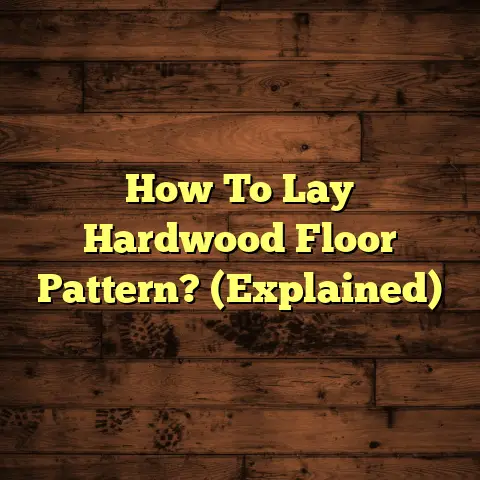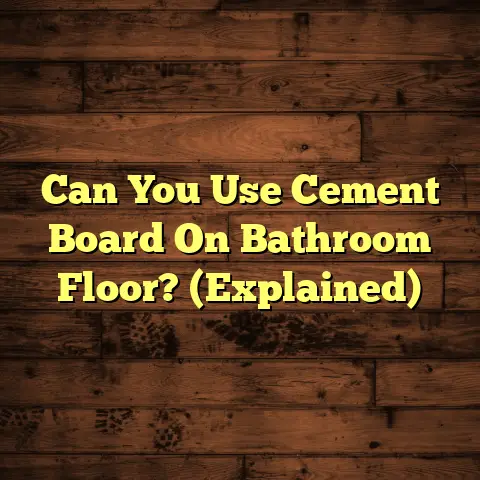Functional Paint Factory Floors? (6 Key Layouts!)
It’s not just about slapping down some epoxy and calling it a day. The layout of your factory, combined with the right flooring, dramatically impacts efficiency, safety, and your bottom line.
Paint factories face unique challenges, like dealing with chemical spills, heavy machinery, and the need for strict safety protocols. So, let’s dive into six key layouts that can transform your paint factory into a cost-effective powerhouse.
Section 1: The Importance of Cost-Effectiveness
in Factory Layouts
What exactly does “cost-effectiveness” mean when we’re talking about industrial flooring? It goes beyond the initial price tag.
It’s about finding the sweet spot where performance meets price, offering the best long-term value. Think about it: cheap flooring might save you money upfront, but what happens when it cracks, chips, or can’t handle the daily grind?
Suddenly, you’re looking at costly repairs, downtime, and even safety hazards. Flooring choices directly impact maintenance costs, durability, and safety.
A durable, easy-to-clean floor reduces maintenance needs, saving you time and money. Slip-resistant surfaces minimize accidents, protecting your workers and reducing potential liability.
And speaking of labor, how does your factory layout affect workflow? An efficient layout minimizes downtime and optimizes the flow of materials and personnel.
This translates to reduced labor costs and increased production output. Let’s consider a real-world example. I once worked with a paint factory that was struggling with constant spills and uneven floors.
They opted for a high-performance epoxy coating with a self-leveling compound. The result? Dramatically reduced cleaning time, fewer accidents, and a noticeable boost in productivity.
According to the Occupational Safety and Health Administration (OSHA), slips, trips, and falls are a major cause of workplace injuries. Investing in slip-resistant flooring can significantly reduce these incidents, saving you money on workers’ compensation claims and lost productivity. (Source: osha.gov)
Section 2: Layout 1 – The Linear Layout
Imagine a straight line. That’s essentially the linear layout. Raw materials enter at one end, and finished products exit at the other.
This layout is super cost-effective because it minimizes transportation time and labor costs. Materials move in a direct, uninterrupted flow, reducing the need for excessive handling.
But what about the flooring requirements? For a linear layout, you need durable, easy-to-clean surfaces that can withstand heavy traffic and potential spills.
Epoxy coatings are a great option, offering excellent chemical resistance and durability. Concrete polishing is another viable choice, providing a smooth, long-lasting surface.
I remember a project where we installed a linear layout in a small paint factory. The owner was initially hesitant about the cost of epoxy flooring, but after seeing the improved efficiency and reduced cleaning time, he was thrilled with the investment.
This layout really shines in high-volume operations where speed and efficiency are paramount. By streamlining the production process, you can significantly reduce labor costs and increase output.
Section 3: Layout 2 – The U-Shaped Layout
Now, let’s bend that straight line into a U-shape. The U-shaped layout brings the beginning and end of the production process closer together.
This allows for closer interaction between different stages of production, leading to significant cost savings. One of the biggest advantages of the U-shaped layout is reduced material handling.
With the input and output points located near each other, materials can be easily moved between workstations, minimizing the need for forklifts and other equipment.
Improved communication is another key benefit. Workers can easily communicate and collaborate, leading to faster problem-solving and increased efficiency.
What about flooring? Slip resistance and ease of maintenance are crucial in a U-shaped layout. Workers are constantly moving between workstations, so you need a surface that provides good traction and is easy to clean.
I once consulted with a paint factory that adopted a U-shaped layout. They were struggling with communication issues and excessive material handling.
After implementing the new layout, they saw a dramatic improvement in both areas. The closer proximity of workstations facilitated better communication, and the reduced material handling saved them a significant amount of time and money.
Section 4: Layout 3 – The Cellular Layout
Think of the cellular layout as a collection of small, self-contained units. Each cell is responsible for a specific task or process, and the cells are arranged in a way that optimizes workflow.
This layout can lead to significant savings in labor and material costs. By focusing on specific tasks, each cell can become highly efficient, reducing waste and improving overall productivity.
The cellular layout also promotes teamwork and collaboration. Workers within each cell can easily communicate and support each other, leading to a more engaged and productive workforce.
Flooring specifications for a cellular layout need to be flexible and adaptable. You might need different types of flooring in different cells, depending on the specific tasks being performed.
For example, a cell that involves heavy machinery might require a more durable flooring option, while a cell that involves delicate assembly might benefit from a softer, more comfortable surface.
I’ve seen cellular layouts work wonders in paint production environments. By breaking down the production process into smaller, more manageable units, factories can significantly improve efficiency and reduce waste.
Section 5: Layout 4 – The Functional Layout
The functional layout groups similar processes together. All the mixing stations are in one area, all the filling stations are in another, and so on.
This layout optimizes cost-effectiveness by reducing transportation time and enhancing workflow. Materials only need to be moved between functional areas, minimizing the need for complex and time-consuming transportation routes.
It allows for specialization. Workers can become highly skilled in their specific functional area, leading to increased efficiency and higher quality output.
Flooring needs in a functional layout are primarily focused on durability and resistance to chemical spills. Paint factories often deal with harsh chemicals, so you need a flooring option that can withstand these substances without degrading or becoming damaged.
Epoxy coatings are a popular choice for functional layouts, offering excellent chemical resistance and durability. Concrete polishing is another viable option, providing a smooth, easy-to-clean surface.
I worked with a paint factory that adopted a functional layout to improve its workflow. They were struggling with bottlenecks and inefficiencies in their production process.
After implementing the new layout, they saw a significant improvement in both areas. The streamlined workflow reduced transportation time, and the specialized workstations increased efficiency.
Section 6: Layout 5 – The Hybrid Layout
Why stick to just one layout when you can mix and match? The hybrid layout combines elements of different layouts to suit specific operational needs.
This layout provides flexibility and can lead to cost savings through tailored workflows. You can combine the benefits of a linear layout with the advantages of a cellular layout, creating a system that is perfectly suited to your specific production needs.
It allows for customization. You can design a layout that optimizes your specific production process, taking into account your unique challenges and opportunities.
Flooring implications for a hybrid layout are complex. You’ll need to consider the needs of each area of the factory and choose flooring materials accordingly.
For example, a high-traffic area might require a more durable flooring option, while a low-traffic area might benefit from a softer, more comfortable surface.
I’ve seen hybrid layouts work wonders in paint factories that have complex production processes. By combining different layout elements, these factories can create a system that is both efficient and adaptable.
Section 7: Layout 6 – The Modular Layout
Last but not least, let’s talk about the modular layout. This layout is all about adaptability and scalability.
It allows for easy reconfiguration as production needs change, making it a great option for growing businesses. Imagine building blocks.
That’s essentially what a modular layout is. You can add or remove modules as needed, allowing you to quickly adapt to changing market demands.
This can be cost-effective. By allowing for easy reconfiguration, you can avoid costly renovations and downtime. You can simply rearrange the modules to optimize your production process.
Flooring requirements for a modular layout focus on durability and ease of installation and removal. You need a flooring option that can withstand heavy traffic and be easily moved or replaced as needed.
Epoxy coatings with a modular design are a great option, offering excellent durability and easy installation. Interlocking tiles are another viable choice, providing a flexible and adaptable surface.
I’ve seen modular layouts transform paint factories. By allowing for easy reconfiguration, these factories can quickly adapt to changing market demands and maintain a competitive edge.
Conclusion
Choosing the right flooring layout for your paint factory is a critical decision. It impacts efficiency, safety, and your bottom line.
We’ve explored six key layouts: linear, U-shaped, cellular, functional, hybrid, and modular. Each layout offers unique advantages and disadvantages.
The key is to choose the layout that best suits your specific operational needs and production process. Remember, cost-effectiveness is about more than just the initial price tag.
It’s about finding the sweet spot where performance meets price, offering the best long-term value. The right layout can lead to enhanced productivity, safety, and long-term savings.
So, take the time to carefully consider your options and choose a layout that will help you achieve your business goals. Trust me, your bottom line will thank you.





